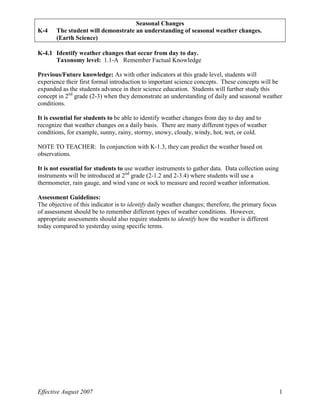
How Seasons Impact Plants and Animals
- 1. Seasonal Changes K-4 The student will demonstrate an understanding of seasonal weather changes. (Earth Science) Effective August 2007 1 K-4.1 Identify weather changes that occur from day to day. Taxonomy level: 1.1-A Remember Factual Knowledge Previous/Future knowledge: As with other indicators at this grade level, students will experience their first formal introduction to important science concepts. These concepts will be expanded as the students advance in their science education. Students will further study this concept in 2nd grade (2-3) when they demonstrate an understanding of daily and seasonal weather conditions. It is essential for students to be able to identify weather changes from day to day and to recognize that weather changes on a daily basis. There are many different types of weather conditions, for example, sunny, rainy, stormy, snowy, cloudy, windy, hot, wet, or cold. NOTE TO TEACHER: In conjunction with K-1.3, they can predict the weather based on observations. It is not essential for students to use weather instruments to gather data. Data collection using instruments will be introduced at 2nd grade (2-1.2 and 2-3.4) where students will use a thermometer, rain gauge, and wind vane or sock to measure and record weather information. Assessment Guidelines: The objective of this indicator is to identify daily weather changes; therefore, the primary focus of assessment should be to remember different types of weather conditions. However, appropriate assessments should also require students to identify how the weather is different today compared to yesterday using specific terms.
- 2. Seasonal Changes K-4 The student will demonstrate an understanding of seasonal weather changes. (Earth Science) Effective August 2007 2 K-4.2 Compare the weather patterns that occur from season to season. Taxonomy level: 2.6-A Understand Factual Knowledge Previous/Future knowledge: As with other indicators at this grade level, students will experience their first formal introduction to important science concepts. Students will further study this concept in 2nd grade (2-3) when they demonstrate an understanding of daily and seasonal weather conditions. It is essential for students to start noticing weather and other daily events or patterns that affect them. Almost everything in nature has some type of pattern. There are patterns that are obvious, such as the seasons. Patterns in weather have a huge effect on our lives. For example, farmers rely on these patterns to know when it is the right time to plant their crops and fishermen rely on patterns to know when and where the best place to fish might be. People even plan their vacations based on the average temperature or annual snowfall in certain areas. The weather is a topic of great interest to all, and one that will engage students in a great education learning adventure. Examples of some weather patterns that are appropriate to compare at this grade level are: Rainy days Sunny days Cloudy days Snowy days Windy days Stormy days It is essential for students to know that weather changes follow a pattern called seasons. There are four different seasons that occur in a repeating pattern: Winter Spring Summer Autumn (Fall) It is not essential for students to collect formal data such as amount of rainfall or temperature. Using weather instruments is a skill that students will add in 2nd grade (2-3.4) to the weather knowledge they are learning at this time. Assessment Guidelines: The objective of this indicator is to compare seasonal weather patterns; therefore, the primary focus of assessment should be to detect ways that these objects are alike and different. However, appropriate assessments should also require students to match pictures or diagrams of various activities, landscapes, or people characterizing weather related features to the appropriate seasons.
- 3. Seasonal Changes K-4 The student will demonstrate an understanding of seasonal weather changes. (Earth Science) Effective August 2007 3 K-4.3 Summarize ways that the seasons affect plants and animals. Taxonomy level: 2.4-A Understand Factual Knowledge Previous/Future knowledge: As with other indicators at this grade level, students will experience their first formal introduction to important science concepts. Students will further study this concept in 2nd grade (2-3) when they demonstrate an understanding of daily and seasonal weather conditions and again in 3rd grade (3-2.4) when they explain how changes in the habitats of plants and animals affect their survival. It is essential for students to know that the seasons affect plants and animals. Examples of ways plants are affected are: Some plants shed their leaves and have bare branches in the winter season. Some leaves change color and fall off during the autumn/fall season. Some plants form leaf and flower buds and flowers in the spring season. Some plants, like trees, have full grown green leaves during the summer. Examples of ways that animals are affected are: Some animals store food for the winter season. Some animals grow warm winter coats and shed that fur when it gets warmer. Some birds fly to a warmer place before the winter season and return in the spring. Some animals, like bears, go to sleep for a long time during winter. It is essential for students to know that some trees will stay green all year and that some lose their leaves each autumn (fall) and grow them back in the spring. It is not essential for students to know the terms deciduous and evergreen. Evergreens do shed (for example, pine trees are evergreens that shed needles but constantly grow new ones that stay green all year long). It is the deciduous trees that lose their leaves each autumn (fall) and grow them back in the spring. Assessment Guidelines: The objective of this indicator is to summarize ways that the seasons affect plants and animals; therefore, the primary focus of assessment should be to give major points or common themes that occur each season. However, appropriate assessments should also require students to match pictures or diagrams of various plants and animals with characteristics unique to specific seasons.